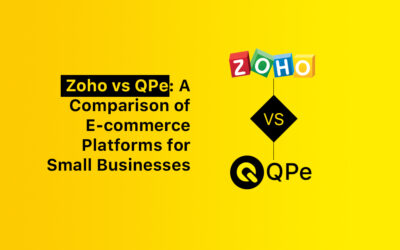The Worldwide B2B E-commerce industry is worth $30.42 trillion in 2024. That’s a massive number, right? But it’s not just about growth. It shows how competitive the space has become. Building a standout brand in B2B E-commerce is no walk in the park.
The good news? Winning is still possible if you use the right strategies. Let’s break it all down. In this blog, we’ll walk you through what makes a solid B2B E-commerce strategy. You’ll see the best practices to adopt, key features to look for in an E-commerce platform, the latest trends to keep up with, and answers to some of your burning questions.
Let’s start with the basics. What’s B2B E-commerce all about? Keep reading.
TL;DR – List of B2B E-commerce Platforms
Want to jump right in? Here’s the list of 5 best B2B E-commerce Platforms:
- QPe
- Shopify
- Magento
- BigCommerce
- OroCommerce
What is B2B E-commerce?
The online sales of products or services via digital platforms is called B2B E-commerce. It is characterized by its focus on efficiency, cost reduction, and customer relationship digitally. It involves selling directly to the buyer (B2B) rather than to the customer (D2C.)
Benefits of B2B E-commerce
Increased Efficiency: B2B lets businesses automate sales and thus handles orders quickly and precisely.
Cost reduction: Digital transaction reduces overhead costs associated with traditional sales methods.
Scalability: these platforms can easily adapt to growing business and expand product lines.
Enhanced Data Insights: B2B businesses leverage data to understand customer data and optimize their offerings
Essential Features of B2B E-commerce Platforms
-
Customizable Product Catalogs
A customizable product catalog allows businesses to show specific products to a specific set of customers, and pricing based on the relationships and agreements. This allows businesses to create a targeted shopping experience for specific customer segments.
-
Advanced Pricing Structures and Discounts
This feature empowers businesses to set up flexible pricing models including bulk discounts, tiered pricing, and customer-specific pricing. It is crucial especially when you are catering to various business clients.
-
Order Management and Automation
This feature enables automation for order tracking, invoicing, and inventory management to ensure that fewer manual errors and operational inefficiencies exist,
-
Integration Capabilities with ERP and CRM
A good e-commerce platform should easily integrate with content relationship management and enterprise resources planning to ensure smooth data flow across several platforms. This increases operational efficiency.
-
Robust Analytics and Reporting
Advanced analytics and reporting tools allow businesses to receive an understanding of a company’s sales trends, customer behavior, or inventory levels to guide businesses in making decisions and strategizing appropriately.
B2B Marketplace Platforms vs. B2b E-commerce Platforms
Let’s clear up some confusion. B2B marketplace platforms and B2B e-commerce platforms might sound the same, but they’re not.
They’re built for different needs. One connects buyers and sellers in one big space. The other? It’s all about running your online store for business customers. The key is knowing which fits your business goals. Let’s dig in.
| Feature | B2B Marketplace Platforms | B2B E-commerce Platforms |
| Ownership | Owned and controlled by a third-party platform. | Fully owned and controlled by the business. |
| Setup Costs | Low initial costs; just a listing or subscription fee. | High startup costs for platform development, hosting, etc. |
| Traffic Source | Leverages the marketplace’s existing audience. | Traffic must be driven through SEO, ads, and other marketing efforts. |
| Branding | Limited scope for branding; all sellers look similar. | Full control over branding, design, and user experience. |
| Competition | Directly competing with other sellers on the same platform. | Standalone presence reduces direct competition. |
| Customer Data | Limited access to customer insights and data. | Full ownership of customer data for personalization. |
| Fees | Commission or fees on every sale. | No revenue-sharing fees; only hosting and payment gateway fees. |
| Trust Factor | Buyers trust the platform rather than individual sellers. | Requires effort to establish trust and credibility. |
| Scalability | Limited scalability is constrained by the platform’s policies. | Highly scalable; can customize based on business growth. |
| Marketing | Marketing is done by the marketplace itself. | Full responsibility for driving and managing traffic. |
| Risk | Lower financial risk; shared platform costs. | Higher risk due to greater investment in setup and operations. |
| Customer Relationship | Limited interaction with customers; controlled by the platform. | Direct relationship with customers fosters loyalty. |
- B2B Marketplace Platforms are ideal for:
- Businesses looking to test the market with minimal investment.
- Companies that benefit from exposure to a large, ready-made audience.
- Sellers that prioritize quick sales over long-term branding.
- B2B E-commerce Platforms are ideal for:
- Businesses that aim to establish their brand identity and retain full control.
- Companies are ready to invest in marketing and infrastructure for long-term growth.
- Sellers who value ownership of customer data and relationships.
Comparison of B2B vs. B2C E-commerce
B2B and B2C e-commerce may both involve selling online, but they couldn’t be more different. B2B focuses on business buyers, while B2C is all about individual customers.
The buying process, pricing, and even how decisions are made are unique for each.
Understanding these differences can help you nail your approach and grow faster. Let’s break it down.
Aspect |
B2B E-commerce |
B2C E-commerce |
| Target audience | Target other businesses like wholesalers, manufacturers, and service providers. | Target individual customers. |
| No. of clients | Clients are of smaller size but most are of high value. | They have a large number of clients with diverse and different demographics. |
| Sales Volume and Value | B2B Involves high-value, low-volume sales. | B2B Deals with low-value, high-volume sales. |
| Sales Cycle | B2B features a longer sales cycle because of product complexity and multiple decision-makers. | B2C mostly has shorter cycles as decisions are quickly made by consumers. |
| Pricing Structure | Prices can be negotiated If you have high order value and good customer relationship. | In B2C, the prices are usually fixed apart from seasonal discounts and offers to attract a hungry crowd. |
| Customer Relationships | Emphasizes long-term relationships and ongoing support. | Focuses on transactional relationships. |
List of B2B E-commerce Platforms
Here are the top 5 B2B e-commerce platforms with advanced b2B capabilities:
-
Qpe:

Overview: Qpe is an e-commerce platform made with advanced B2B like tiered pricing, customizable catalogs, and seamless third-party integrations.
Pros: Zero transaction fees, user-friendly, dedicated support, and fast loading times allow businesses to manage operations efficiently and provide personalized support through dedicated relationship managers.
Cons: Advanced features may require a higher-tier plan, but the platform is still cheaper than most other platforms offering similar capabilities.
2. Shopify

Shopify
Overview: Shopify offers advanced features like administrative and management, API integrations, growth tools, and additional services.
Pros: User-friendly interface, scalable solutions for B2B E-commerce.
Cons: Higher costs and may require third-party apps for complete B2B functionality.
3. Magento (Adobe Commerce:)

Magento (Adobe Commerce)
Overview: Magento is an open-source platform that offers huge customization capabilities and complex B2B operations.
Pros: Highly flexible with powerful marketing and catalog management tools.
Cons: Requires high cost and technical expertise for setup and maintenance
4. BigCommerce:

Bigcommerce
Overview: Bigcommerce combines eCommerce solutions with specialized B2B features like custom pricing and self-service capabilities.
Pros: It offers strong scalability and built-in SEO tools.
Cons: It takes time because of the steeper learning curve.
5. OroCommerce:

Overview: OroCommerce is designed to address unique B2B needs offering features like multi-organization support and advanced pricing models.
Pros: Focused on customization and integration with ERP systems.
Cons: It requires technical resources.
How to Develop an Effective B2B E-commerce Strategy
-
Define Goals and KPIs for B2B E-commerce
Set your clear B2B objectives for sales, customer acquisition, or user experience. Monitor Key Performance Indicators such as conversion rates, average order values, and customer retention rates.
-
Map Customer Journey for B2B Buyers
Create a comprehensive customer journey map that highlights the stages of your B2B customers. Start with “awareness,” and end with “becoming your loyal raving fans”. Identify key touchpoints, pain points, and decision-making processes involved in their buying journey. Understanding this journey helps tailor your approach to meet their specific needs effectively.
-
Optimize Product Information and Content
It should be easy to understand and accessible: product information encompasses descriptions, specs, pricing structures, and high-quality images of the product. On top of this, there must be valuable content regarding common pain points and questions B2B buyers are likely to have. This includes case studies, whitepapers, and instructional videos.
-
Choose the Right Marketing Channels
Identify the right marketing channels for reaching. It may include channels like email marketing, LinkedIn, content marketing, and search engine optimization (SEO). Craft your campaigns to resonate with business buyers.
-
Focus on Customer Retention and Loyalty Programs
Implement strategies that would increase customer retention through good service delivery and support at every step of the buying process. Loyalty programs to encourage repeat buys or referrals can also be implemented. Building a relationship with customers brings much lifetime value and advocacy.
Best Practices for B2B E-commerce Success
-
Simplify the User Experience
Simplify navigation and reduce complexity in the purchasing process. Secure the website is intuitive, buyers can find products easily, and complete transactions quickly. A user-friendly interface enables customer satisfaction and encourages repeat business.
-
Leverage Content Marketing
Develop content that speaks to specific B2B buyer pains and issues. Whitepapers, case studies, and informative blog posts are some examples of types of content that demonstrate your thought leadership position, drive traffic to your site, and nourish leads through the buying process.
-
Use Automation
Initiate automation tools for order processing, inventory management, and communication with the customers. This helps you minimize much human error that happens in the process and save time, making your team focus on other strategic sides of the business instead of performing repetitive tasks.
-
Build Strong Relationships with B2B Buyers
Foster relationships through personalized communication. Use CRM systems to track interactions and preferences, and thereby give them customized offers and support tailored to specific customer needs.
-
Ensure Seamless Mobile and Multi-Device Access
Make your e-commerce website mobile-friendly and increase the number of B2B shoppers. A consistent experience on all devices with responsive design lets customers shop at any time and from anywhere.
Enjoying this article? Consider saving these for later:
B2B vs B2C Ecommerce: What’s the Difference? (2024)
Know The Key Differences Between B2B and B2C e-commerce Websites
What are the Current B2B E-commerce Trends?
-
Growth of Mobile Commerce in B2B
According to Intelemark, 80% of B2B buyers are using mobile devices at various stages of their purchasing journey. This shows how mobile in B2B commerce is gaining significant importance, forcing businesses to rethink strategies for engagement and conversion on smaller screens for mobile users. It emphasizes the need for responsive design and mobile-friendly platforms.
-
Increasing Use of AI and Personalization
With the help of recommendation engines and predictive analytics, businesses are leveraging AI. Today, Personalization is a must-have when serving your B2B eCommerce customers. A recent Zendesk survey had 76% of respondents suggesting that they expect personalized experiences,
Apart from personalized experience and predictive analytics; Businesses have started using AI to improve operational efficiency, make data-driven decisions, manage customer relationships, and much more. With that being said, the AI B2B race is crossing all the barriers.
-
Role of Data Analytics in B2B E-commerce
Analyzing data in B2B E-commerce helps deliver essential insights into buyer behavior and the refinement of sales strategies. Businesses, through the use of analytics, make informed predictions about demand, monitor purchasing, and refine their marketing efforts for more effective and efficient operations.
-
Enhanced Security and Compliance Standards
With the large number of B2B companies acquiring omnichannel strategies, the buyer experiences a seamless journey in exploring, comparing, and purchasing the product online and through mobile applications and in-store. Such methods often increase convenience and customer satisfaction.
Frequently Asked Questions(FAQs):
-
What Is the Role of Mobile Commerce in B2B E-commerce?
The role of M-commerce within B2B E-commerce encompasses enhancing accessibility and convenience for the buyer, improving customer loyalty and engagement through personalization, and improving the purchasing process in being faster.
-
How Can Data Analytics Improve B2B E-commerce?
Data analytics in B2B E-commerce help to optimize the marketing strategy, make forecast demands, and enhance the product offerings. They give insights into the customers’ behavior, preferences, and purchasing patterns. On getting these insights, an appropriate decision is made by a business.
-
Why Is Customization Important in B2B E-commerce?
Customization in B2B E-commerce helps businesses mold their offerings according to the client’s needs. Personalized experiences like customized product catalogs, pricing structures, and marketing messages help businesses enhance customer satisfaction and loyalty.
This gives businesses a competitive edge; leading fosters long-term relationships with clients.
-
How Do AI and Personalization Affect B2B E-commerce?
AI and Personalization help B2B E-commerce businesses improve user experience and increase conversion rates and customer retention by targeting the specific needs of each buyer.
Conclusion
B2B e-commerce is changing fast. To keep up, businesses need the right tools to stay competitive. The platforms we looked at can help you grow without overspending. They’re packed with features like automation and customization to meet the unique demands of B2B.
Need a tool that does it all? Check out QPe. It can streamline your processes, save money, and grow your business, all while staying affordable.
One last thing, success in B2B e-commerce isn’t just about offering a good product. It’s about giving your buyers a smooth and personalized experience. Ready to make that happen? Let’s go!



